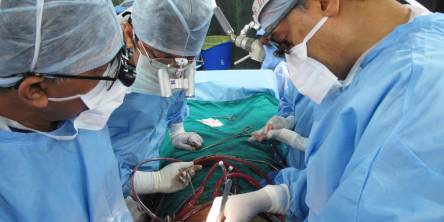All You Need to Know About Congenital Heart Disease


Congenital heart disease is a term used to define a group of different kinds of conditions that affect the heart. These problems will begin to affect the baby’s heart during while the baby is in the womb. Congenital heart disease is categorized to know the problems that baby may experience. And they are
Problems that cause too much blood to pass through the lungs
These types of congenital heart defect cause increased pressure and stress in the lungs.
- Patent ductus arteriosus (PDA)
Patent ductus arteriosus is often noticed in premature infants. This defect causes blood to mix between the aorta and the pulmonary artery. While the baby is in the womb, there will be an open passageway between the aorta and the pulmonary artery and this open passageway must close after birth. When this open passageway does not close, some blood returns to the lungs causing Patent ductus arteriosus (PDA).
- Atrial septal defect
The atrial septal defect causes abnormal blood flow through the heart due to an abnormal opening between the right and left atria (two upper chambers of the heart).
- Ventricular septal defect
The ventricular septal defect causes the blood from the left ventricle to flows back into the right ventricle (due to higher pressure in the left ventricle) because of an abnormal opening between the right and left ventricles (two lower chambers of the heart). This abnormal blood flow often creates congestion in the lungs.
- Atrioventricular canal (AVC or AV canal)
Atrioventricular canal is called for complex heart problems that include several abnormalities of structures inside the heart. These structural abnormalities include atrial septal defect, ventricular septal defect, and improperly formed mitral and/or tricuspid valves.
Problems that cause too little blood to pass through the lungs
These heart problems don’t allow oxygen-rich blood to flow throughout the body causing the baby to appear in blue in colour (cyanotic)
- Tricuspid atresia – There won’t be any blood flow from right atrium to the right ventricle due to the absence of tricuspid valve
- Pulmonary atresia – In this condition pulmonary valve is underdeveloped and pulmonary atresia is a very complicated congenital heart disease
- Transposition of the great arteries - Transposition of the great arteries is due to the reverse positions of the pulmonary artery and the aorta
- Tetralogy of Fallot - Tetralogy of Fallot is due to four defects
- ventricular septal defect;
- A Stenosis (narrowing) at or just beneath the pulmonary valve that blocks the flow of blood from the right side of the heart to the lungs;
- A right ventricle that is more muscular than normal and often enlarged;
- An aorta that lies directly over the ventricular septal defect.
- Double outlet right ventricle – In this condition, the pulmonary artery, and the aorta are connected to the right ventricle.
- Truncus arteriosus - In this condition, the pulmonary artery and the aorta start as a single blood vessel, which will later divide and become two separate arteries. Truncus arteriosus happens when the single great vessel fails to separate completely, leaving a connection between the aorta and pulmonary artery.
Problems that cause too little blood to travel to the body
Body won’t get sufficient amount of blood due to these heart defects (underdeveloped chambers of the heart or blockages in blood vessels)
- Coarctation of the aorta (CoA) – Blood flow to the lower part of the body is obstructed due to narrowing (constricted) of aorta creating increased blood pressure above the constriction.
- Aortic stenosis (AS) – aortic valve is not properly formed or may be narrowed causing problems in blood flow to the body
- Hypoplastic left heart syndrome (HLHS) – this is due to a combination of several abnormalities of great blood vessels and heart.
Causes for congenital heart disease
Most of the reasons are unknown. Some of them are due to
- Genetic problems
- Medications (anti-seizure medicines) taken by mom for some disease while pregnant
Testing and diagnosis for congenital heart disease
Pediatric cardiologist will prescribe for
- Fetal echocardiogram
- Electrocardiogram (EKG)
- Cardiac magnetic resonance imaging (MRI)
- Cardiac catheterization
Treatments for congenital heart disease
- Medications
- Cardiac surgery
- Cardiac catheterization
Similar Articles
Today every third human is facing heart disease, and it's not a good sign. A recent study says that out of 10, the reason for death for 8 people is heart failure.
A quarter of all deaths is caused by heart disease in the UK. This means that every three minutes, someone dies due to heart complications. These figures are worrying. But, luckily, there are things you can do every day to reduce your risk of developing heart disease.
Heart conditions such as heart disease, heart failure, arrhythmia etc. are much more common than people think. Every day millions of people are living with some form of a heart condition.
Premature heartbeats are a kind of heart rhythm disturbance, which may signal about some more serious heart malfunctions. Nevertheless, premature heartbeats can occur both in individuals who have developed coronary heart disease or cardiomyopathy and in those, with a healthy organ.
Did you know that choking, snoring, shortness of breath, daytime drowsiness and multiple episodes of nighttime waking are all indications that you may be suffering from obstructive sleep apnea? OSA has been linked as a precursor to multiple health conditions such as hypertension, heart disease, diabetes, and even Sudden Cardiac Death.
The majority of people experience “arrhythmias” (irregular heartbeats) at some point in their lives. Most of the time, these arrhythmias occur in healthy people (free of heart disease).
Before knowing how to survive a heart attack, you must first know what is happening to your body
There are mainly four types of valves present in our heart and they are mitral, tricuspid, aortic
Don’t treat your heart disease as your fate. Although there are some risk factors that we are not able to control, there are some risk factors that we can control.









